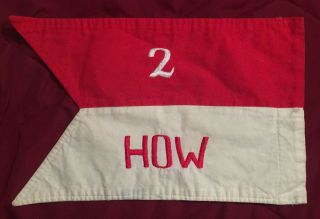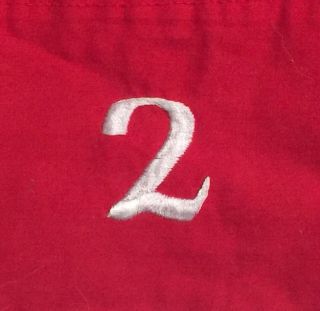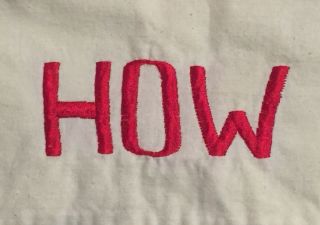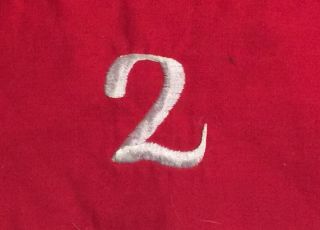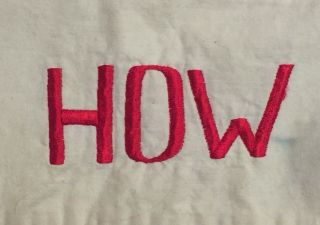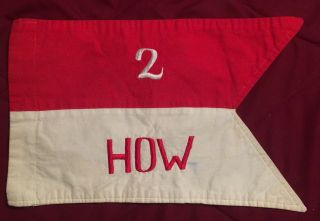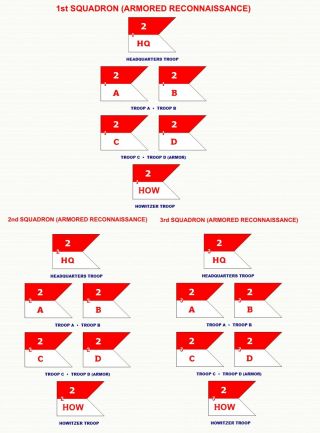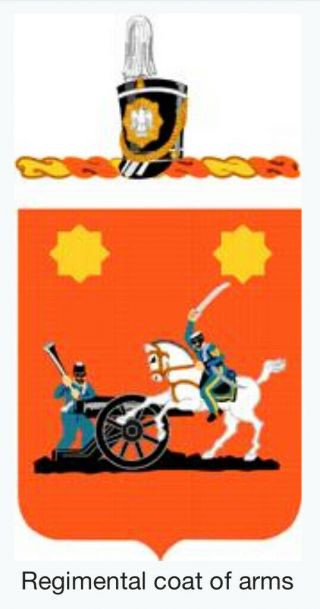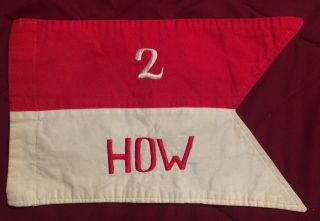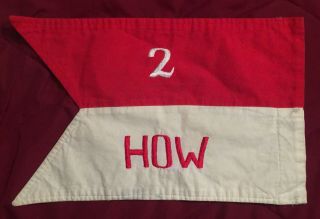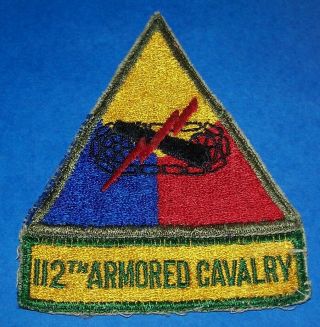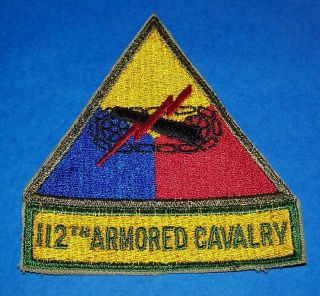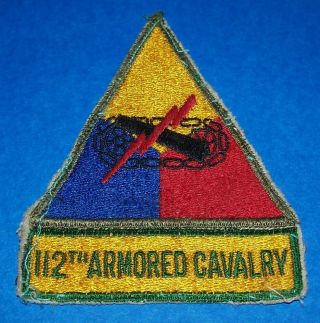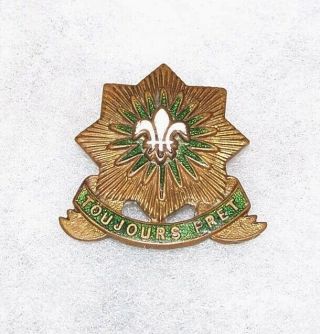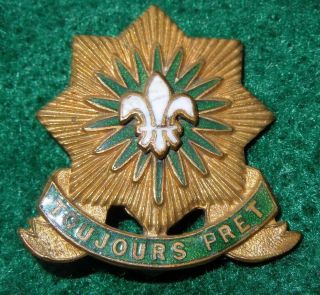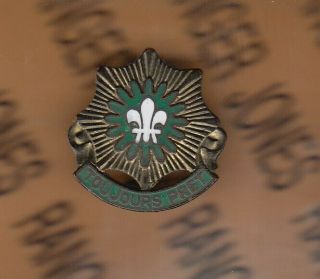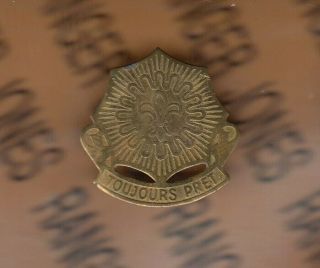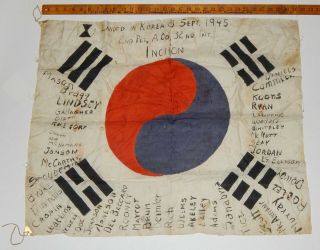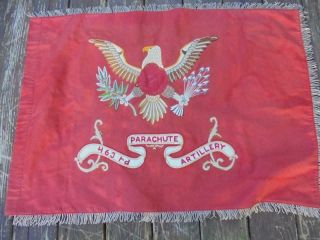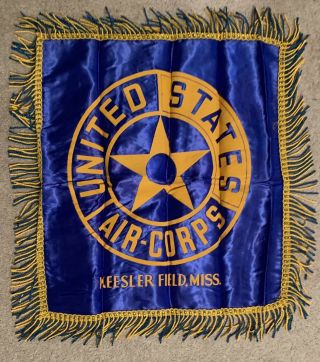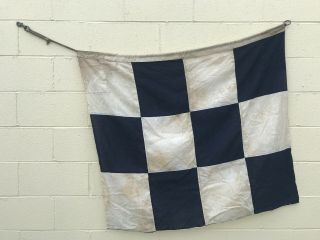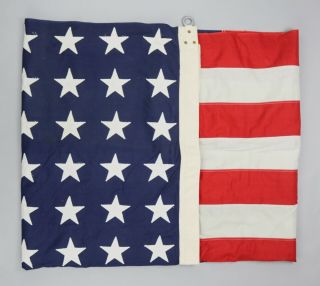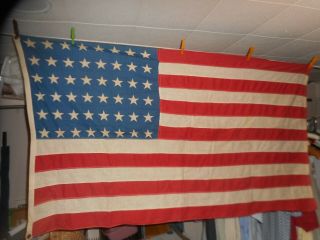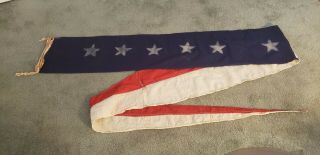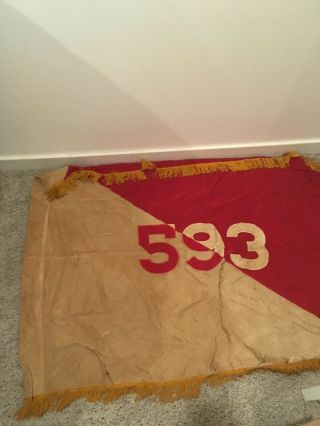Post WW2 2nd Armored Cavalry Regt HOWITZER Co Guidon GERMAN OCCUPATION 1953 - 55
Item History & Price
| Reference Number: Avaluer:64217 | Country/Region of Manufacture: United Kingdom |
| WW 1: US Flag | WW2: US Flag |
This Jeep Guidon is much higher quality than an Issued Guidon. This is a theater made guidon. This piece was made in Germany after 1953 and before 1955 during German Occupation and Defense against the Iron Curtain and the RED SCARE.**********************
For your consideration is a POST WW2 Howitzer Troop, 2nd Armored Cavalry Reg’t Jeep Guidon manufactured between 1953-1955. It was manufactured before the 2D ACR returned to the US in Operation Gyroscope.
This piece looks to have been made before the HOW guidon could have been issued from the US with the conversation of the 2D ACR to the 2D ACR Combat Team in 1953. This looks to be the one of the earliest guidons with 2D ACR, HOW Co. This was most definitely an official guidon for an officers use while in Germany.
This is a hand embroidered Jeep Guidon that measures 9.5” by 13.5”. This is a theater made guidon in Germany.
The 70th Armored Field Artillery Battalion joined the 2nd Armored Cavalry Reg’t in Germany 1948 to become the Howitzer Troop of Squadrons 1, 2, & 3.
HISTORY OF 2nd Cavalry Regiment 1948-1955****************
Occupation and Guard on the Iron Curtain
At the end of World War II the Second Cavalry Group, Mechanized, was screening the area between Pilsen and Nepomuk. The unit, as the most advanced element of the 3d Army, had reached that line on May 7 when orders were received to halt the advance. This was according to inter-Allied agreement on demarkation lines. Between the limits set forth for the U.S. and Soviet Armies in Czechoslovakia, a ten kilometer-wide buffer zone had been established. The Second was pushing patrols to the very limit of that zone in order to establish contact with the Russians, who had not yet appeared in that sector. Aside from this, the unit was occupied tactically with the apprehension of small groups of German soldiers, who were infiltrating from the east in order to avoid being taken prisoners by the Soviet. A platoon from B-42 fulfilled an additional task by guarding the German Prisoner Brigade Viechech.
It was a disappointment to the men of the Second when the 4th Armored Division, to the south of the group sector, made first contact with the Russians. However, the group soon had its curiosity satisfied. During the night of May 9, a Soviet armored column roared into Nepomuk, intent on proceeding to Pilsen, which had been occupied by the 16th Armored Div. since early on May 8. The 42d Squadron, stationed in Nepomuk, had considerable difficulty in persuading the Russians that they had gone far enough. Apparently no word of the freeze order had reached them yet. The tankers of the Second were a little disconcerted when they found that there were female soldiers in the Red Army. On the following morning a patrol finally located the Russian Corps Commander, 25th Tank Corps, who also had to be convinced that there was no need to advance farther. A meeting was arranged with Lt. Colonel Hargis, commanding 42d Squadron; and on the I I th Colonel Reed escorted the Russian to a reception given by Major General Erwin, commanding general of the XII Corps.
The interlude in Czechoslovakia was a short one for the Second Cavalry; and between May 12 and 18 the various units moved to their new locations directly across the German border in the Landkreis (county) Koetzting, as part of the Army of Occupation. The move from Czechoslovakia was especially painful for Group HQ; which had been luxuriously housed at Zinkovy, in the castle of the Czech munitions baron, Skoda. It was now transferred to a tourist hotel and ski lodge at Brennes. During the summer it moved to Koetzting. There they closely supervised the activities of German authorities, and assisted the military government detachments, which soon took over this duty from the tactical units.
For several months the activity of the Second was confined to the checking of traffic by means of road blocks, and the control of the Czech border. B Troop-2 was guarding the 11th Panzer Div., which had surrendered intact to the 90th Inf. Division. This was the same unit that had given the group a rough time at Luneville. Also under custody of the unit was the Prisoner Brigade Viechech, which had been moved from Czechoslovakia to Lohberg, and was now gradually dissolved by discharge. To lend color to this routine duty, group parades were again held; with a newly formed band and a mounted color guard. The age of the horse seemed to have returned, and the unit was able to put on horse shows with some of the five hundred horses taken from Hostau. First class recreation facilities for the men were provided at a lodge on a little mountain lake. There was a fine recreation program, restricted only by the necessity of having to import dancing partners all the way from Klatovy, Czechoslovakia. This was due to the ban on fraternization with the Germans, which was still enforced by stiff fines. It was not until the late summer of 1945 that the troops could legally associate with the local belles.
As it became apparent that no large force was needed to occupy an exhausted and war-torn Germany, most of the American troops in the country were gradually withdrawn. This caused an enlargement in the territory assigned to each of the remaining units. The Second consequently had to move elements into the counties of Viechtach, Regen, and Grafenau during the summer and fall. During the same period the group was rapidly depleted of the veterans who had been with it from Ft. Jackson to Czechoslovakia. The great number of replacements received meant training once again, to keep the outfit "second to none."
At the end of 1945 it became clear that the occupation forces in Germany would have to be reorganized in order to carry out the great task assigned to this relatively small number of troops. At this time, the military was wholly responsible for policing the zone of occupation, and providing for the maintenance of security and order. Circumstances in Germany were all but chaotic, mass starvation threatened; and a black market flourished which was doubtlessly unprecedented in history. The problem was aggravated by millions of homeless people, displaced persons, and refugees, who were living in dilapidated camps without any means of making a livelihood. In addition, there was still fear (probably groundless) of an uprising or an organized resistance movement on the part of the German population. (As we shall see, there were actually some efforts made to bring such a movement into being, but in retrospect we can safely say that this probably never constituted a major danger.) All these factors made it necessary that a force be organized, which could be stationed in a central location; and would be able to rapidly reach any trouble spot, and deal with any contingency. Of the organizations then existing in the Army, the cavalry groups were best suited for such a mission. Consequently the Second was assigned the duties of a District Constabulary for the Eastern Military District (comprising essentially the State of Bavaria) as of January 1, 1946. The 42d Squadron set up its headquarters at Freising, and the 2d moved to Schwandorf. Before this move was completed, Troop A was ordered to Kempten, in the southwest corner of the state, to carry out a special mission; whose exact nature was kept secret even from the troops engaged in it.
Arthur Axmann, a high ranking Nazi and for many years leader of the Hitler Youth, had been ascertained to be hiding at a remote farm near the Austrian border. Intelligence had learned that he had made several trips through Germany in attempts to organize a nationalist underground movement. Since it was imperative that Axmann be captured alive, it was impractical to arrest him at his hide-out, which could not be approached without being observed from the house. Past experience indicated that high Nazi leaders carried suicide capsules which would cause instantaneous death when bitten open and swallowed. For this same reason it was necessary that the arrest be made suddenly. Intelligence had been received to the effect that one of Axmann's collaborators would pick him up at a prearranged time for a meeting with other leaders of the projected underground group. Since Axmann was in the possession of forged papers, he had been able to pass routine road blocks before; and had no reason to avoid them. Troop A therefore set up checkpoints at all roads leading to Axmann's hide-out. All the troopers were well briefed on the Nazi leader's appearance, but did not know the identity of their quarry. This precaution was taken to prevent word of Axmann's capture leaking out before the CIC was ready to close in on his associates. A momentary crisis arose when an overexcited guard at a checkpoint stopped the car and gave its occupants reason to become suspicious. However, after some anxious waiting the car was finally stopped at a roadblock near Kempten, and Axmann was found to be in it. The occupants were asked into a house, as if to make a routine inspection of their papers, and then suddenly overpowered by a group of men from HQ Platoon under Lt. Pridgen. Axmann was later tried with the other top Nazi leaders at Nuernberg, and received a long prison sentence.
In December 1945, General George S. Patton died in a highway accident. Colonel Charles H. Reed, a close personal friend of the General, was placed in charge of arrangements for the funeral. According to the wish of his widow, the great commander was laid to rest among thousands of men of his Third Army at an American cemetery near Luxembourg City. For the impressive ceremonies, the 2d Squadron furnished a color guard; and the 42d a mechanized escort squadron, which moved to Luxembourg in a forced march of four hundred miles on December 22/23.
The District Constabularies were intended to be merely a temporary force while the plans for a permanent Zone Constabulary were worked out. A headquarters for this unit was established in January of 1946, and Major General Ernest N. Harmon, who had fought with the regiment in World War I, was appointed its first commander. Since none of the established tables of organization in the army fitted the mission of the constabulary, a new type of unit had to be developed. For the Second this entailed the return to regimental organization as one of nine Constabulary Regiments.
On Jan. 15 the 2d Squadron moved to Sonthofen, where it established the Constabulary School. Another contribution of our unit was the design of its shoulder patch, the "Circle C." Between Feb. 15 and March 20 the Second reorganized for its new mission and became the 2d Constabulary Regiment. Within the organization there were three squadrons: the 2nd, the 42nd, and the new 66th, formed from the former 66th FA Battalion. These squadrons were composed of a HQ and Sv. Troop, three reconnaissance, and two mechanized troops each. In addition, the regiment included a Tank Troop, a Medical Detachment, and a motorcycle platoon. The cavalry tradition was upheld by a horse platoon, which furnished the color guard for several years; and did valuable work patrolling areas along the Czech border which were impassable to vehicles, while on detached duty with the 6th and 14th Constabulary Regiments.
By April the squadrons had taken up their new stations. Regimental HQ and the 42d Squadron was at Freising; the 2d at Lenggries, and the 66th at Degerndorf, near the Austrian border. During the next few months the new organization was thoroughly tested by numerous practice alerts. By July 1, 1946 (the operational date) the U.S. Constabulary was all it was intended to be; an elite unit, highly mobile, and ready for instantaneous action. To demonstrate the latter, the 42d Squadron was alerted on a Saturday afternoon to move to a designated point one hundred twenty miles distant. Most of the men on pass, yet the unit managed to gather them, and arrive at its objective within six hours after the alert was given, with not a vehicle missing. At the same time the regiment also made a fine record in shooting competitions with other constabulary outfits, and remained unexcelled in athletics.
The Second's new duties consisted mainly of police work, raids on black market centers, and an occasional show of force to discourage any would-be conspirators. A nation-wide black market ring was broken up in the fall of 1946. A platoon of C Troop-42, stationed at Ingolstadt, tracked down some men who had broken into the local food office and stolen a large number of ration stamps. It was discovered that they belonged to a well organized ring of black marketeers, who were subsequently arrested by American and British officials.
That such police work occasionally entailed real excitement and danger is shown by a case which occurred late in 1946. The Third Platoon of C Troop-2 had been successful in identifying a group of bandits, who had committed a series of robberies and murders in the vicinity of Murnau. They finally tracked down two of the gang leaders to an isolated barn by extracting a confession from one of the men's wives. When the barn was surrounded one of the criminals came out; but the other, Kubala, refused to surrender. Sergeants May, Gibson, and Ftitsch, as well as a German policeman, finally entered the barn. They had to withdraw when May was badly wounded by a bullet in the chest. The platoon leader, still intent on taking Kubala alive, had the barn dismantled by a ten-ton wrecker. 'They found that the bandit had taken his own life rather than he caught.
Aside from police duties, the Second also was one of the show outfits in Europe, and in that capacity participated in a goodly number of parades. Outstanding among these was one held in the impressive Königsplatz square in Munich for the Army Chief of Staff, General Dwight D. Eisenhower on October 14, 1946. The whole regiment had been assembled from its various stations. It passed in review in a long column of glistening vehicles, led by Colonel Reed and the staff on horseback. A few days before that, Colonel Reed and several other officers had participated in an inter-Allied horseshow at Innsbruck, Austria. The show was long remembered for the fine hospitality shown by the French hosts.
Police duty continued to be the main mission of the Second through most of 1947. There were occasional thriller cases such as a quadruple ax murder, but for the most part duty consisted of routine operations combating the black market. This was made more difficult by regulations which forbade the troops to enter the camps of the so-called displaced persons. As they were under UNRRA supervision, the military had to have iron-clad proof of an offense. Because of this situation the unit finally resorted to a blockade. They set up road blocks surrounding the DP camp at Wolfratshausen, and checked every vehicle entering or leaving the camp. T'his was kept up for a week; and in the process great quantities of black market goods were recovered, and illegal activity was curbed for the time being. An important aspect of the service of the regiment throughout this period was its German Youth Activities program. A full time staff organized groups which conducted an active program, including everything from dances and crafts exhibitions to discussion groups. Much good will was built through this activity, and a sound foundation laid for better German-American understanding.
In September of 1947 the Regimental Headquarters, and the 2d and 42d Squadrons moved to Augsburg, where the unit was joined by the 68th Squadron. Activity now began to center around training. The 66th Squadron, remaining at Degerndorf, continued its border patrol and police work. During late 1947 and continuing during the next year, the elements in Augsburg received intensive training in all military subjects. This included a course in air mobility which involved the loading of equipment on mock-up aircraft, and was climaxed by an actual flight in cargo plane.
The coup by which the Czech government was taken over by the Communists did much to shift the emphasis in security from guarding against the scarcely existing Nazi danger to a new awareness of a real Communist threat. The actual police role of the Constabulary declined as the German police assumed fuller responsibilities, and the black market was dealt a mortal blow by a reform of the German currency in June of 1948. In December of that year the regiment was reorganized in accordance with the new tactical emphasis and became the 2d Armored Cavalry Regiment. However, it continued to be part of the U. S. Constabulary until that organization was abolished in 1952. The 2d Squadron became the 1st Battalion, and the 42d and 68th, the 2nd and 3rd Battalions respectively. The 66th Squadron was transferred out of the regiment.
During the following years the unit was constantly engaged in training. One battalion was in the field at nearly all times to furnish aggressor details, for the unit tests and field exercises. The security platoon in HQ Co. continued to perform a secondary police mission, but was mainly concerned with processing complaints and forwarding them to higher headquarters. The emphasis was once more on combat readiness; particularly after June 1950, when the Reds struck in Korea. There were many large scale maneuvers and map exercises, six in 1951 alone. The largest of these operations, "Combine, " took place in the fall of that year; and was held in the British Zone, with British troops participating. Earlier in the year, the regiment had cooperated with French forces in Exercise "Jupiter, " which had involved over one hundred and fifty thousand men. Most of the time the regiment was designated as part of the Aggressor forces, and there was a lot of griping about the necessity of being "defeated" every time.
In October of 1951 the regiment moved to the Nuernberg area. Regimental Headquarters was established in that city, as was the rest of the Provisional Battalion. The other battalions took up stations at Bindlach near Bayreuth (1st), Bamberg (2d), and Amberg (3d). Detachments from the 1st Bn. were also stationed at Hof and Arzberg (later discontinued), and the 2d Battalion had companies at Kronach and Coburg. These detached units were rotated at regular intervals. In addition to maintaining combat readiness, the regiment now had a new mission. This was to patrol the border in cooperation with the new German Border Patrol Police. It was a strange feeling for the troopers to stand on the very fringe of the Iron Curtain; knowing that this was not a boundary like any other, but a dividing line between two utterly opposed ways of life. Occasionally they spoke to refugees who managed to cross that border, in spite of all measures on the part of the Communists to prevent them; and they knew that the land across the line was in the grip of a tyranny such as man had never known. There was pride in the knowledge that they, the men of the Second Cavalry, now stood guard on the edge of freedom. Occasionally shots were fired from across the line, and our soldiers replied. Such incidents were rare; and border patrol for the most part meant weariness, bad weather, and long hours. For the regiment it meant that there was a job to be done.
In the meantime training was kept up; and each unit semi-annually spent two weeks at Grafenwoehr, a former German training camp. Here field maneuvers were held, and range firing conducted.
The traditions of the regiment were not neglected during this period. During 1948 a new color guard was organized, clothed in the uniforms of the dragoons of 1836. This fine group has marched ahead of the regiment at all formal occasions since, a constant reminder of the brave past of the Second. In 1951 the deactivated 2d, 19th, and 776th Tank Battalions were consolidated with the regiment from which these outfits had been organized back in 1942. This added the streamers "Leyte" and "Ryukyus" to the unit's colors, and gave us the right to wear the Presidential Unit Citation won by the Second Tank Battalion at Bastogne. In 1952 the Second invited the French Conde Dragons and the British Queen's Bays, the "2d Dragoons" of their respective armies, to send representatives to its organization day celebration. This visit led to a close relationship among the three units, and visits were exchanged regularly on ceremonial occasions during the remainder of the unit's service in Germany.
The Second, throughout its stay in Germany, remained the magnificent outfit that had fought under Patton. Its role changed from occupation force to defense force, its mission from police duty to tactical readiness, its name from Cavalry to Constabulary, and back to Cavalry. Yet the Second was always prepared, always ready to do its duty. Relations with the German civilian population, so important in view of that country's reestablishment as a sovereign power, became notably good in spite of difficulties. There were a few things such as damage to farmers' crops during maneuvers (for which the owners received full compensation), and occasional cases of troopers getting out of hand. This was outweighed by the good will the Second built up by participating in many charitable projects; such as Christmas parties for underprivileged children, and its fine Youth Activities program. A good public information program also helped relations; and Germans were invited to parades, organization day celebrations, and other activities. When the regiment left Germany, the Lord Mayor of Bamberg presented a scroll to the Second Battalion; praising the unit for its fine part in creating better U.S.-German relations. The regiment showed that it could not only defeat an enemy, but also win friends.
The Second Cavalry returned to the United States during the summer of 1955. They exchanged stations with the 3d Armored Cavalry under the Army's "Operation Gyroscope, " which brought about a return to rotation by unit, rather than by individual.
An advance party flew to the States in June 1955, and arranged the many details the regiment's new station. The regiment left Europe, its home for over eleven years, in the middle of August. The 1st and 2d Battalions embarked at Bremerhaven aboard the transport USS Buckner and arrived in New York on August 22. The Provisional and 3d Battalions followed two days later, completing the final leg of the journey to Ft. George Meade, Md., by rail. Upon arrival many of tile men, whose term of service was about to expire, were discharged; and the others were granted leaves in two groups.
As soon its the regiment was settled at its new station, it went to work again. It had to get the equipment that had been left by the 3d Cavalry into top shape for inspections which came thick and fast. Since then the unit has been conducting basic and advanced training to provide replacements for its sister regiment, the 3d, and for other units. At all times its high state of combat readiness has been maintained by inspections, and field training at Camp A. P. Hill, Va., and Ft. Stewart, Ga. Ceremonial occasions mean parades, and a proud moment came for the unit when a picked company marched down Pennsylvania Avenue in the parade honoring President Eisenhower's second inauguration on January 21, 1957.
At present the regiment is made up of three battalions. Each has its own headquarters company, three reconnaissance, a howitzer, and a tank company. The Regimental Headquarters Company, Service Company, and Medical Detachment complete the unit's makeup. The latest outfits to join the 2d Cavalry family were the three howitzer companies. Along with several other supporting units they had been attached to the regiment in Germany as the 70th Armored Field Artillery Battalion. With their addition, the unit now combines the punch of artillery with its traditional armor and infantry roles, to make up a powerful, well balanced striking force.
Yes, the Second Cavalry is still following its motto. In spite of all the changes that the last one hundred and twenty years have brought; devotion to duty, and the ability and willingness of the cavalry to be first on any field have remained unchanged. The "Dragoons" have a glorious history to be proud of, and the regiment can be trusted to uphold its fine tradition whenever and wherever it may be called upon. Captain May and Colonel Cooke, Sergeant Hagan, Major Pleasonton, and all the others have ridden into history; but it was they who shaped their regiment's present by setting a standard that we must live tip to. Therein lies the meaning of military tradition. Keep this in mind and adhere to our high standard: this is our challenge. Thus the future of the Second will always be equal to its past.
I have located multiple 2D ACR yearbooks from 1950 through 1958. The HOW Co is mentioned in 1952 with the Combat Team as the 70th Armored F.A. Battalions and as HOW Co without the 70th Arm F.A. Batt from 1953 on. *****************************



